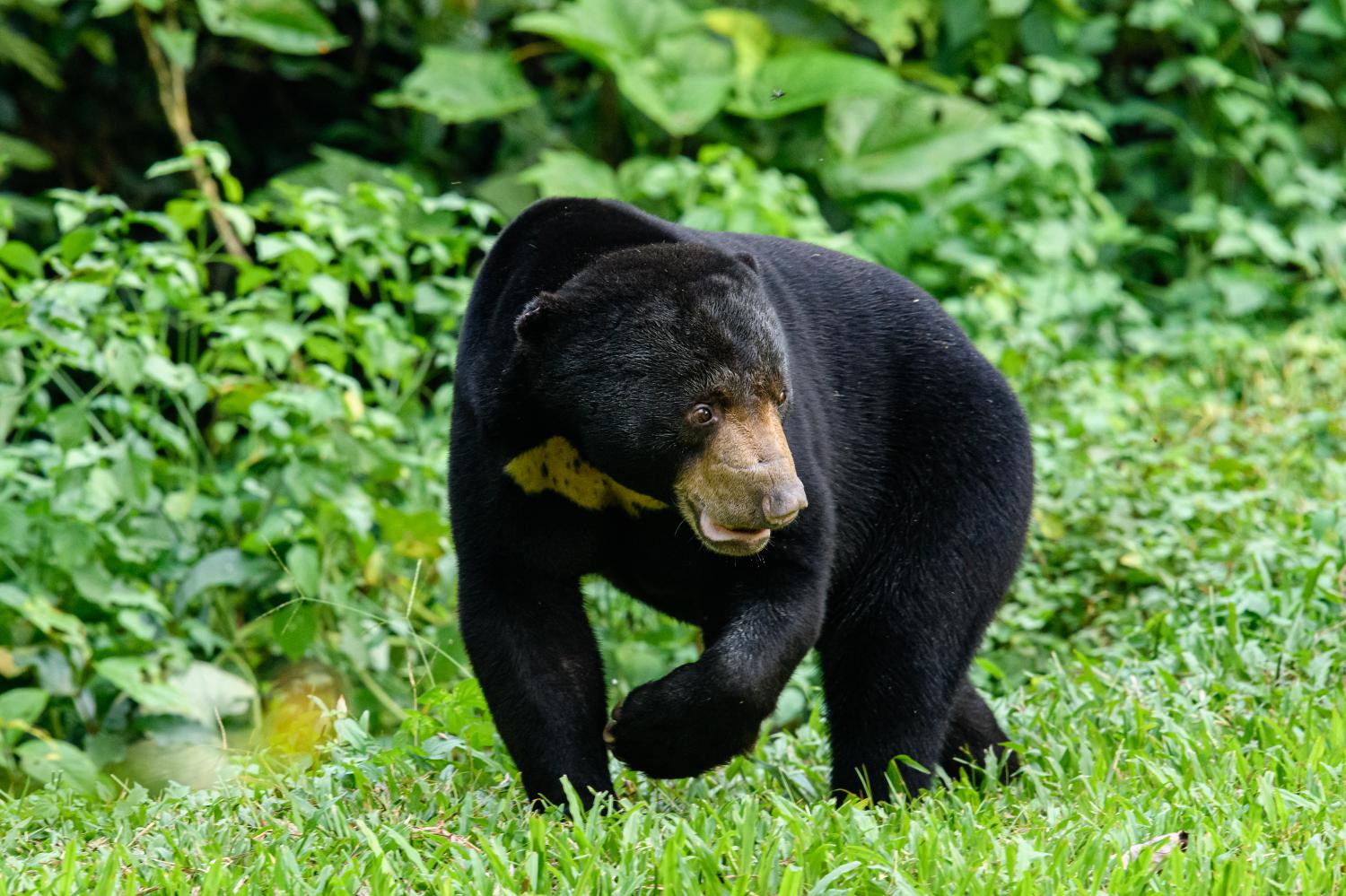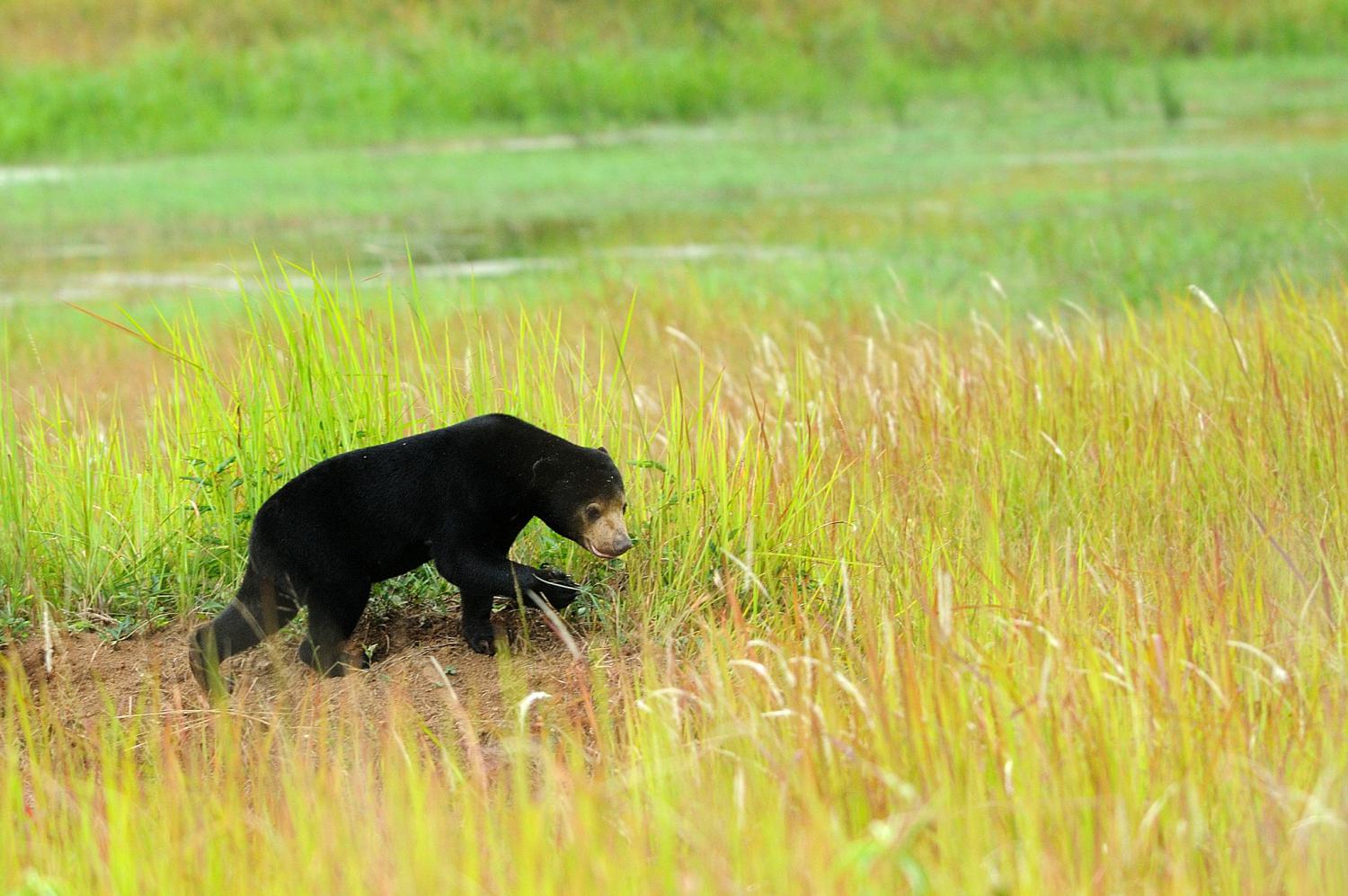Species of Thailand
Sun bear
Helarctos malayanus
Thomas Stamford Raffles, 1821
In Thai: หมีหมา
The sun bear (Helarctos malayanus) is a bear found in tropical forest habitats of Southeast Asia. It is classified as Vulnerable by IUCN as the large-scale deforestation that has occurred throughout Southeast Asia over the past three decades has dramatically reduced suitable habitat for the sun bear. It is suspected that the global population has declined by more than 30% over the past three bear generations.
The Malayan sun bear is also known as the "honey bear", which refers to its voracious appetite for honeycombs and honey.
Characteristics
The sun bear's fur is jet-black, short and sleek with some under-wool. There are two whirls on the shoulders, from where the hair radiates in all directions. There is a crest on the sides of the neck and a whorl in the centre of the breast patch. There is always a more or less crescent-shaped pale patch on the breast that varies individually in colour ranging from buff, cream or dirty white to ochreous. The skin is naked on the upper lip. The tongue is long and protrusible. The ears are small and rounded, broad at the base and capable of very little movement. The front legs are somewhat bowed with the paws turned inwards, and the claws are cream.
The sun bear is the smallest of the bears. Adults are about 120 - 150 cm long and weigh 27 - 65 kg. Males are 10–20% larger than females. The muzzle is short and light coloured, and in most cases the white area extends above the eyes. The paws are large, and the soles are naked, which is thought to be an adaptation for climbing trees. The claws are large, curved and pointed. They are sickle-shaped and relatively light in weight. The tail is 30 - 70 mm long.
During feeding, the sun bear can extend the exceptionally long tongue 20 - 25 cm to extract insects and honey.
It has very large canines and high bite forces in relation to its body size, which are not well understood, but could potentially be related to its frequent opening of tropical hardwood trees in pursuit of insects.
Distribution and habitat
Sun bears are found in the tropical rainforest of Southeast Asia ranging from north-eastern India, Bangladesh, Myanmar, Thailand, Peninsular Malaysia, Laos, Cambodia, Vietnam to southern Yunnan Province in China, and on the islands of Sumatra and Borneo. They now occur very patchily through much of their former range, and have been extirpated from many areas, especially in mainland Southeast Asia. Their current distribution in eastern Myanmar and most of Yunnan is unknown.
The bear’s habitat is associated with tropical evergreen forests
Distribution of subspecies
- H. m. malayanus (Raffles, 1821) — inhabits Asian mainland and Sumatra;
- H. m. euryspilus (Horsfield, 1825) — occurs only on the island of Borneo.
Helarctos anmamiticus described by Heude in 1901 from Annam is not considered a distinct species but is subordinated to H. m. malayanus.
Ecology and behaviour
As sun bears occur in tropical regions with year-round available foods, they do not hibernate. Except for females with their offspring, they are usually solitary.
Male sun bears are primarily diurnal, but some are active at night for short periods. Bedding sites consist mainly of fallen hollow logs, but they also rest in standing trees with cavities, in cavities underneath fallen logs or tree roots, and in tree branches high above the ground.
In captivity they exhibit social behavior, and sleep mostly during the day.
Diet
Bees, beehives, and honey are important food items of sun bears. They are omnivores, feeding primarily on termites, ants, beetle larvae, bee larvae and a large variety of fruit species, especially figs when available. Occasionally, growth shoots of certain palms and some species of flowers are consumed, but otherwise vegetative matter appears rare in the diet. In Bornean forests, fruits of Moraceae, Burseraceae and Myrtaceae make up more than 50% of the fruit diet. They are known to tear open trees with their long, sharp claws and teeth in search of wild bees and leave behind shattered tree trunks.
Sun bear scats collected in a Forest Reserve in Sabah contained mainly invertebrates such as beetles and their larvae, termites and ants, followed by fruits and vertebrates. They break open decayed wood in search of termites, beetle larvae, and earthworms, and use their claws and teeth to break the standing termite mound into a few pieces. They quickly lick and suck the contents from the exposed mound, and also hold pieces of the broken mound with their front paws, while licking the termites from the surface of the mound. They consume figs in large amounts and eat them whole. Vertebrates consumed comprise birds, eggs, reptiles, turtles, deer and several unidentified small vertebrates. Hair or bone remains are rarely found in sun bear scat.
They can crack open nuts with their powerful jaws. Much of their food must be detected using their keen sense of smell.
Reproduction
Females are observed to mate at about 3 years of age. During time of mating, the sun bear will show behaviour like hugging, mock fighting and head bobbing with its mate.
Gestation has been reported at 95 and 174 days. Litters consist of one or two cubs weighing about 10 g each. Cubs are born blind and hairless. Initially, they are totally dependent on their mother, and suckle for about 18 months. After one to three months, the young can run, play and forage near their mother. They reach sexual maturity after 3–4 years, and may live up to 30 years in captivity.
Threats
The two major threats to sun bears are habitat loss and commercial hunting. These threats are not evenly distributed throughout their range. In areas where deforestation is actively occurring, they are mainly threatened by the loss of forest habitat and forest degradation arising from clear-cutting for plantation development, unsustainable logging practices, illegal logging both within and outside protected areas and forest fires.
The main predator of sun bears throughout its range is by far man. Commercial poaching of bears for the wildlife trade is a considerable threat in most countries. During surveys in Kalimantan between 1994 and 1997, interviewees admitted to hunting sun bears and indicated that sun bear meat is eaten by indigenous people in several areas in Kalimantan. High consumption of bear parts was reported to occur where Japanese or Korean expatriate employees of timber companies created a temporary demand. Traditional Chinese medicine shops in Sarawak and Sabah offered sun bear gall bladders. Several confiscated sun bears indicated that live bears are also in demand for the pet trade.
Sun bears are among the three primary bear species specifically targeted for the bear bile trade in Southeast Asia, and are kept in bear farms in Laos, Vietnam and Myanmar. Bear bile products include raw bile sold in vials, gall bladder by the gramme or in whole form, flakes, powder and pills. The commercial production of bear bile from bear farming has turned bile from purely a traditional medicinal (TCM) ingredient to a commodity with bile now being found in non-TCM products like cough drops, shampoo and soft drinks.
Tigers and other large cats are potential predators.
A wild female sun bear was swallowed by a large reticulated python in a lowland dipterocarp forest in East Kalimantan. It is possible that the python had come across the sleeping bear. Other predators on mainland Southeast Asia and Sumatra could potentially be the leopard and the clouded leopard although the latter could be too small to successfully kill an adult sun bear.
Conservation
Helarctos malayanus is listed on CITES Appendix I since 1979. Killing of sun bears is strictly prohibited under national wildlife protection laws throughout their range. However, little enforcement of these laws occurs.
In captivity
The Malayan sun bear is part of an international captive breeding program and has a Species Survival Plan under the American Zoo and Aquarium Association since late 1994. Since 1994, the European Studbook for sun bears is kept in the Cologne Zoo, Germany.
This article uses material from Wikipedia released under the Creative Commons Attribution-Share-Alike Licence 3.0. Eventual photos shown in this page may or may not be from Wikipedia, please see the license details for photos in photo by-lines.
Scientific classification
- Kingdom
- Animalia
- Phylum
- Chordata
- Class
- Mammalia
- Order
- Carnivora
- Family
- Ursidae
- Genus
- Helarctos
- Species
- Helarctos malayanus
Common names
- German: Malaienbär
- English:
- Malayan sun bear
- Sun sear
- Spanish:
- Oso de sol
- Oso malayo
- Oso Malayo
- French:
- Ours des cocotiers
- Ours malais
- Ours Malais
- Italian:
- Orso malese
- Orso del sole
- Dutch: Maleise beer
- Russian: Малайский медведь
- Swedish: Malajbjörn
- Thai:
- หมีหมา
- หมีคน
Synonyms
- Ursus malayanus, Thomas Stamford Raffles (1821)
Conservation status
(IUCN3.1)
Photos
Please help us review our species pages if wrong photos are used or any other details in the page is wrong. We can be reached via our contact us page.
Range Map

- Huai Kha Khaeng Wildlife Sanctuary
- Huai Yang Waterfall National Park
- Kaeng Krachan National Park
- Khao Ang Rue Nai Wildlife Sanctuary
- Khao Laem National Park
- Khao Soi Dao Wildlife Sanctuary
- Khao Sok National Park
- Khao Yai National Park
- Khlong Lan National Park
- Khlong Saeng Wildlife Sanctuary
- Kui Buri National Park
- Nam Nao National Park
- Pang Sida National Park
- Phu Khiao Wildlife Sanctuary
- Sadeth Naikrom - Krom Luang Wildlife Sanctuary


